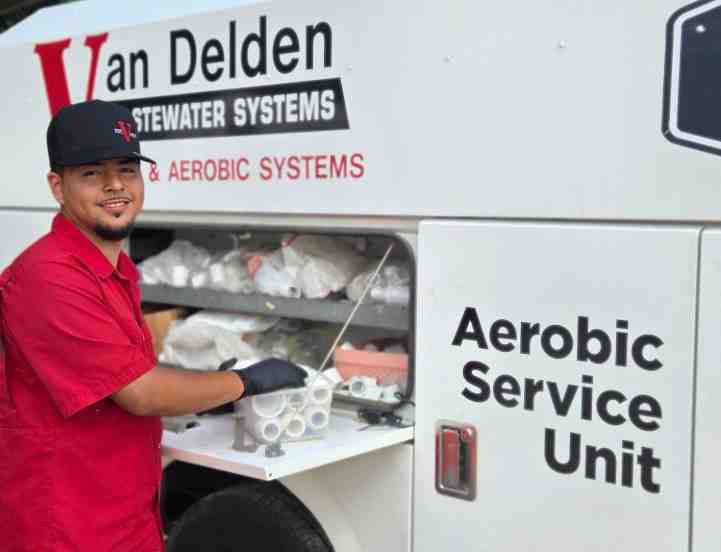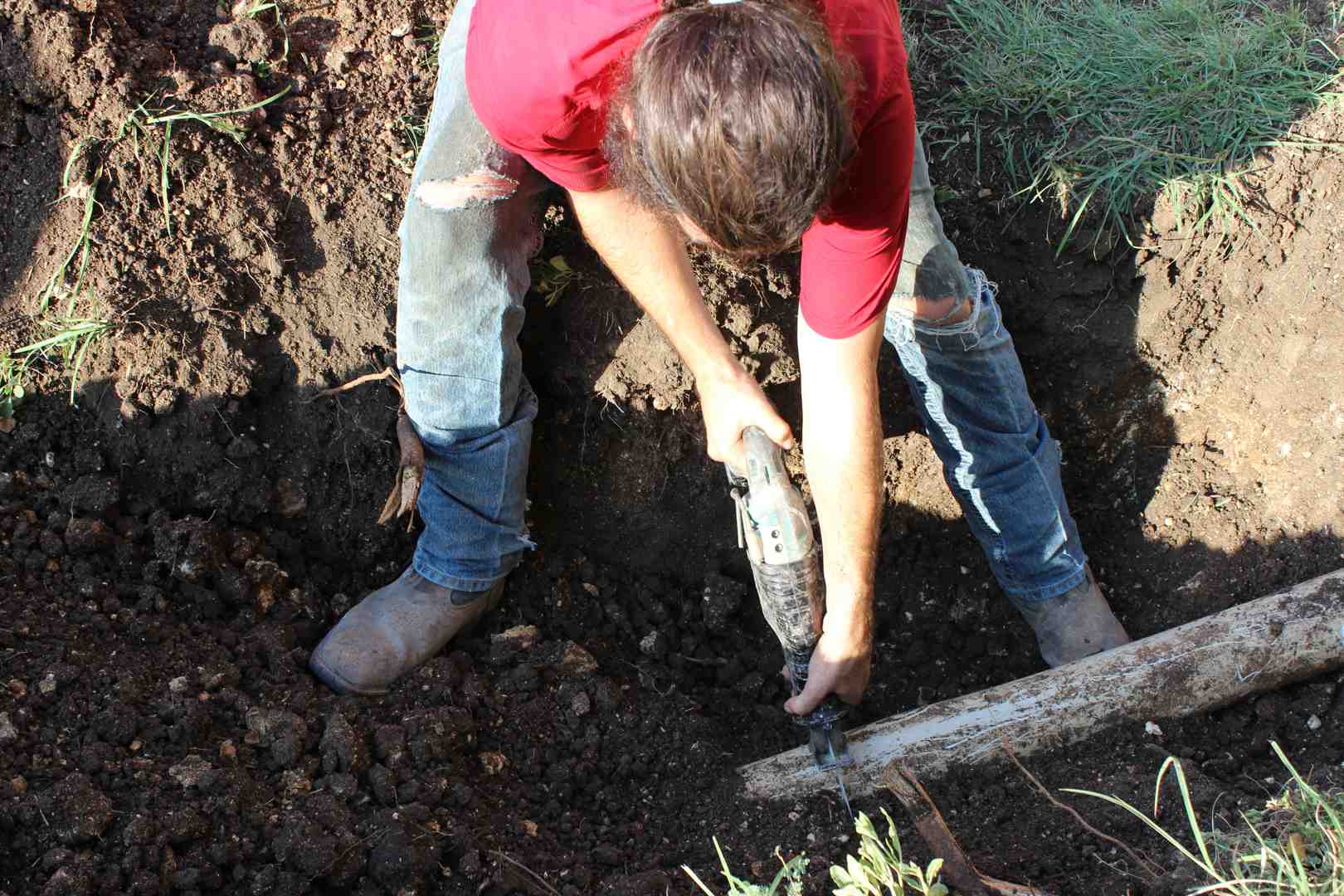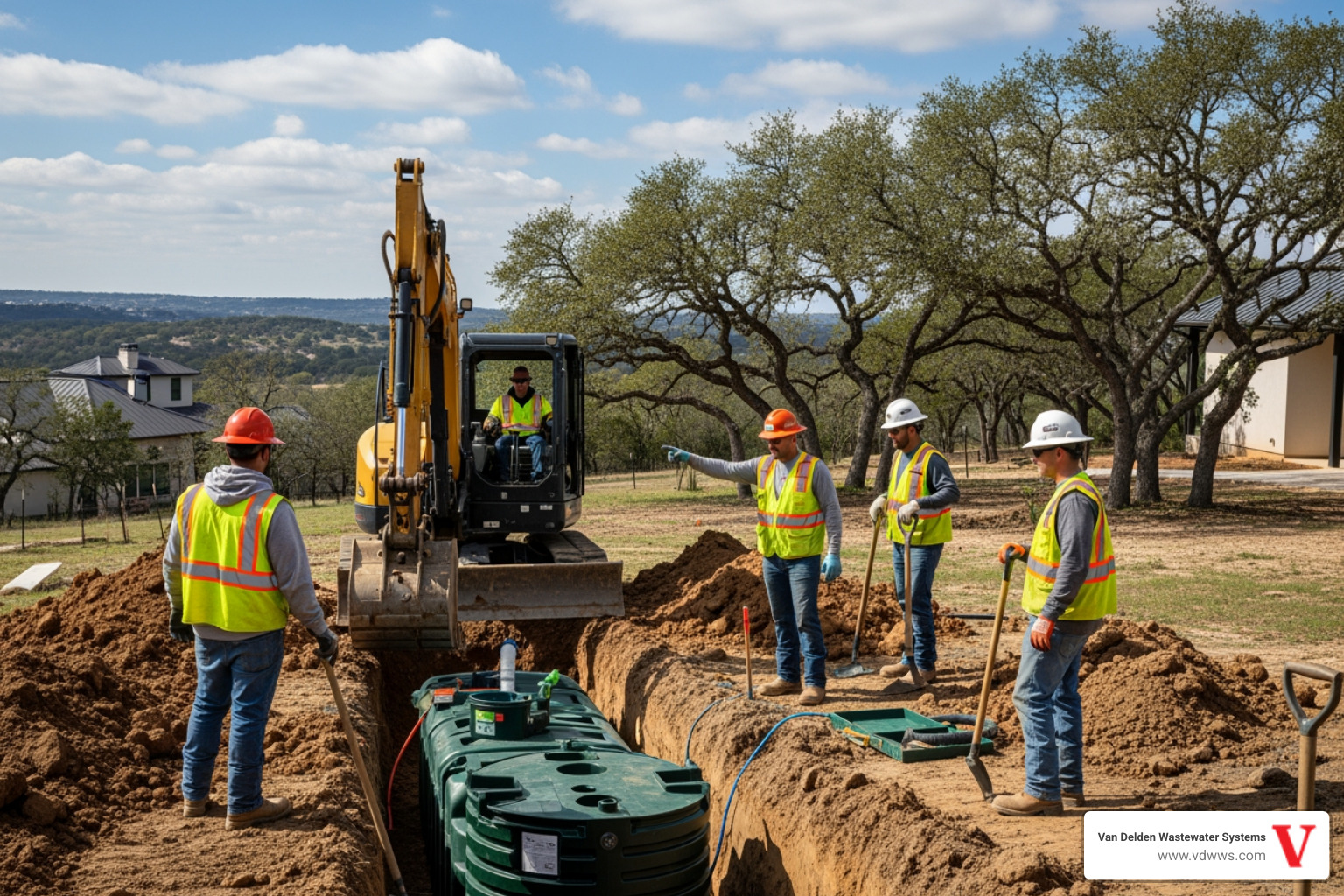Understanding How Your Septic System Works
Understanding how septic works is essential for every homeowner with an on-site wastewater treatment system. Here's the basic process:
Quick Answer:
- Wastewater flows from your home to the septic tank
- Solids separate - heavy materials sink, oils float, liquid remains in middle
- Bacteria break down organic waste in the tank
- Liquid effluent flows to the drainfield through perforated pipes
- Soil naturally filters the wastewater before it reaches groundwater
Approximately one in five households in the United States depends on a septic system, which is a personal wastewater treatment plant in your backyard. Unlike municipal sewer systems, your septic system handles everything on-site using natural processes. Understanding your septic system is crucial for avoiding costly repairs. A properly maintained system can last 20-30 years, while neglect can lead to failure in just a few years, costing thousands in repairs or replacement.
The beauty of septic systems lies in their simplicity. They use gravity, beneficial bacteria, and soil to treat wastewater naturally. Basic systems don't require electricity or monthly sewer bills and are environmentally friendly when properly maintained.

The Anatomy of a Septic System: Key Components Explained
To understand how septic works, you need to know the key components working together beneath your yard. The three main parts are the septic tank, the drainfield (also called a leach field or soil absorption field), and the soil itself. They work together to treat wastewater until it's clean enough to rejoin the groundwater.
Wastewater leaves your home through the main sewer pipe and flows to the septic tank. From there, partially treated liquid goes to a distribution box, which spreads it evenly throughout your drainfield.
Want to explore beyond the basics? Check out our guide on Common Septic System Types to see how different systems handle this process.

The Septic Tank
Your septic tank is a large, watertight container buried in your yard that separates solids from liquids. Most tanks are built from concrete tanks, fiberglass tanks, or polyethylene tanks. Concrete is durable but can crack, while fiberglass and plastic tanks resist cracking and rust.
The tank's design is key. The inlet baffle directs wastewater downward to avoid disturbing settled layers. The outlet baffle ensures only the middle layer of liquid leaves the tank. Many systems also include an effluent filter to catch fine particles before they can cause trouble downstream.
Inside your tank, nature creates a three-layer system. The scum layer floats on top, containing oils and grease. The sludge layer forms at the bottom as heavy solids settle. Between them sits the effluent layer—the clear, partially treated liquid that's ready for the next step.
The Drainfield (or Leach Field)
Once effluent leaves the septic tank, it heads to the drainfield—the final treatment area. This is a sophisticated natural treatment system, not just a dumping ground.
Your drainfield has perforated pipes laid in gravel trenches. Effluent is slowly released through holes in the pipes, seeping through the gravel and into the unsaturated soil below.
The distribution box is crucial for spreading effluent evenly across the drainfield pipes, preventing some areas from being overloaded.
The size and design of your drainfield depend on your household size and soil type. Sandy soil drains quickly, while clay soil needs more surface area to handle the same amount of wastewater.
To see this entire process in action, take a look at this helpful animated model of a household septic system. Watching the animation really helps you visualize how all these components work together to treat your home's wastewater naturally.
The Journey of Wastewater: How Septic Works Step-by-Step
Understanding how septic works is clearer when you trace the step-by-step journey of wastewater. Gravity and natural processes work together to transform dirty water into clean groundwater. The process uses wastewater flow patterns, natural bacterial processes, and soil filtration to handle everything from your household.
For a comprehensive look at this process, check out More info about How Septic Systems Work.
Step 1: From Your Home to the Tank
All water that goes down your drains, including blackwater from toilets and greywater from sinks, showers, and washing machines, flows into your home's main drainage pipe. Gravity carries the wastewater through the inlet pipe into the septic tank for initial collection. Every time someone in your house uses water, they're adding to this continuous flow that your system is designed to handle.
Step 2: Separation and Decomposition in the Septic Tank
Once wastewater enters the septic tank, it slows down, allowing separation to occur. Heavy solids like waste and food particles sink to form the sludge layer. Lighter materials like oils and grease float to form the scum layer. The liquid in the middle becomes the effluent layer.
The tank is a biological factory where billions of anaerobic bacteria (which don't need oxygen) work to break down organic solids. They decompose waste into water and other substances. However, not all solids break down, leading to sludge accumulation. This is why regular pumping is essential to prevent the sludge layer from becoming too thick and interfering with the system.
This bacterial breakdown process is why we always emphasize proper maintenance. For more insights, read More info about Why You Should Have Your Septic Tank Cleaned.

Step 3: Effluent Flows to the Drainfield
After about 24 hours in the tank, the partially treated effluent exits through the outlet pipe, which draws liquid from the middle layer, avoiding the scum and sludge. Many modern systems have an effluent filter at the outlet to catch stray particles, preventing clogs in the drainfield.
Next, the effluent flows to a distribution box. This component's job is to ensure wastewater spreads evenly across all the perforated pipes in your drainfield. The distribution box role is critical for system longevity because it prevents any single area from becoming overloaded, which could lead to premature system failure.
Understanding these potential failure points is crucial. Learn more by reading More info about 4 Common Causes of Septic Drainfield Failure.
Step 4: Final Treatment in the Soil
In the final step, effluent trickles from the perforated pipes and begins percolating through layers of unsaturated soil, which acts as a natural water treatment plant. The soil provides physical natural filtration, trapping particles. More importantly, a diverse community of soil microorganisms performs the final biological treatment.
These aerobic bacteria (which use oxygen) break down remaining contaminants and perform pathogen removal, eliminating harmful bacteria and viruses to protect groundwater quality. The soil also excels at nutrient removal, converting nitrogen and phosphorus into harmless compounds.
By the time the water completes this journey, it's clean enough for groundwater recharge, showcasing nature's remarkable purification ability.
Want to dive deeper into the science? Michigan State University explains How soil treats wastewater from Michigan State University.

Protecting Your Investment: Maintenance, Problems, and Lifespan
Now that you understand how septic works, let's discuss how to keep it running well for its full 20-30 year lifespan. Proper care prevents unpleasant and expensive surprises. Septic maintenance is like car care—regular attention protects your investment and the environment. Failing systems release harmful bacteria and nutrients into soil and groundwater, which can contaminate waterways and make people sick.
For comprehensive support with your system, we're here to help. You can find More info about Septic System Maintenance on our website.
Essential Maintenance Practices
Keeping your septic system healthy requires regular attention. Here are the key practices to keep your system running smoothly.
Pumping every 3-5 years is essential. Indigestible materials build up as sludge and scum, and without regular pumping, these layers can flow into and damage your drainfield. Your specific pumping schedule depends on tank size, household size, and water usage. For personalized guidance, check out More info about How Often Should My Septic Tank Be Cleaned?.
Regular inspections by a professional can spot small issues like a cracked baffle or early drainfield problems before they become major, expensive repairs.
Water conservation is also vital. Overloading your system can flood the drainfield, so spread out laundry loads, fix leaks, and use high-efficiency appliances.
Protecting the drainfield is crucial. Never drive, park, or build on it, as the weight can crush pipes and compact soil. Plant only grass, as tree roots can damage pipes. Direct gutters and sprinklers away from the area to prevent oversaturation.
What NOT to Flush Down the Drain
Your system is designed to handle human waste and toilet paper. Anything else can cause problems.
Grease and oils solidify in pipes, causing clogs and contributing to the scum layer. Dispose of them in the trash, not the sink.
"Flushable" wipes do not break down like toilet paper and cause severe clogs. Feminine hygiene products, diapers, and cotton swabs also belong in the trash.
Harsh chemicals like bleach and drain cleaners kill the beneficial bacteria your system needs to break down waste. Use them sparingly.
Paint, pharmaceuticals, and other chemicals can contaminate groundwater. Dispose of them through proper hazardous waste programs.
Use a garbage disposal sparingly. It adds a large volume of solids to your tank, meaning you'll need to pump it more often.
For a comprehensive list of septic system no-nos, take a look at More info about Things You Think You Can Flush But Really Can't.
Recognizing Signs of a Failing System
Septic systems usually give warning signs before they fail. Recognizing them can save you thousands of dollars.
Foul odors around your septic tank or drainfield are a clear warning sign.
Gurgling drains and slow drainage can indicate a backup in your pipes or a failing drainfield.
Sewage backup into your home is an emergency and a health hazard that requires immediate professional attention.
One of the most telling signs is lush green grass or soggy spots over your drainfield, especially during dry weather. This usually means untreated wastewater is surfacing and indicates serious drainfield problems.

When septic systems fail, they can contaminate drinking water wells, make people sick, and damage local ecosystems. If you notice any of these warning signs, contact a septic professional immediately. Early intervention can often prevent minor problems from becoming major disasters. For more detailed information, see More info about Signs of a Backed Up Septic System.
Beyond the Basics: System Types, Costs, and Regulations
Now that you understand how septic works in its basic form, let's explore the bigger picture. While the conventional system is common in areas like San Antonio, Shavano Park, and Spring Branch, Texas, other options exist for properties with challenges like poor soil, high water tables, or specific regulations. Think of conventional systems as standard trucks and advanced systems as specialized vehicles for tougher conditions.
Conventional vs. Advanced Septic Systems
The main difference between conventional and advanced systems is the level of wastewater treatment before it reaches the soil and how it's dispersed. The goal is to match the system to your property's specific needs.
Conventional systems use gravity and anaerobic bacteria, relying on good soil for final purification. They are ideal for sites with permeable soil and adequate space.
Advanced septic systems are for sites where conventional systems aren't suitable, such as those with clay soil, small lots, or high water tables. They use extra treatment steps or pumps to handle these challenges.
Here's how the most common system types compare:
| Feature | Conventional System | Aerobic Treatment Unit (ATU) System | Mound System |
|---|---|---|---|
| Treatment | Anaerobic in tank, aerobic in soil | Aerobic in ATU (uses air pump), then soil | Anaerobic in tank, then aerobic in constructed sand mound |
| Soil Suitability | Requires good, permeable soil | Suitable for poor soil, high water table, or limited space | Used when native soil is too shallow or has poor percolation |
| Components | Septic tank, distribution box, drainfield | Septic tank, aerobic treatment unit, pump, sometimes disinfection unit, smaller drainfield or spray field | Septic tank, pump chamber, sand mound (containing drainfield), fill material |
| Maintenance | Pumping every 3-5 years, general care | More frequent inspection/maintenance (often quarterly), regular pumping, power consumption | Pumping every 3-5 years, mound integrity checks, often requires professional monitoring |
| Dispersal | Gravity-fed into soil | Can be spray-applied, drip irrigated, or gravity-fed into a smaller drainfield | Effluent is pumped into the mound, then naturally filters through sand and native soil |
Aerobic Treatment Units (ATUs) pump air into the tank to support aerobic bacteria, which are more efficient at breaking down waste. This produces cleaner effluent but requires electricity and more frequent maintenance.
Mound systems create an artificial drainfield with a raised bed of sand and gravel. They are used when native soil is too shallow or drains poorly.
Drip systems use a network of tubing to distribute effluent slowly over a large area. They are good for difficult sites but need more maintenance.
The EPA offers a comprehensive EPA's overview of septic system types if you want to dive deeper. For those interested in aerobic systems, we've got More info about Aerobic Systems that covers their unique requirements.
Understanding Septic System Costs
Understanding septic system costs helps you plan. Costs vary based on system type, site challenges, and local rules.
Installation costs are lowest for simple, conventional systems on ideal lots. Costs increase with challenges like slopes, poor soil, or the need for advanced systems like mound systems, which require more materials and labor.
System lifespan is typically 20-30 years with proper maintenance, making the upfront investment cost-effective over time.
Repair costs range from minor (a clog) to major (a failed drainfield). Regular maintenance is key to preventing expensive repairs.
Pumping costs every 3-5 years are your main ongoing expense. This regular maintenance protects your larger investment, much like an oil change for your car.
A well-maintained septic system is cost-effective over its lifespan, avoiding the endless monthly bills of a municipal sewer connection.
For specific information about maintenance costs, you can check out More info about How Much Will It Cost to Clean My Septic Tank?. And if you're considering a new installation, we offer comprehensive services detailed at More info about Septic System Installation Services.
Conclusion
We hope this guide has clarified how septic works. Your system is a personal water treatment plant, and understanding it empowers you to take better care of it. Knowing about the bacteria in the tank and the delicate drainfield helps you avoid harmful chemicals and damaging activities.
Proper care is simple and consistent: pump the tank every 3-5 years, be mindful of what goes down the drain, and watch for warning signs. This small investment prevents major headaches down the road.
A properly functioning system also protects the environment by keeping groundwater and local streams free from contamination. That's something to feel good about as a homeowner.
At Van Delden Wastewater Systems, we've been helping families understand and maintain their septic systems since 1937. We focus on prevention, because we know that educated homeowners have healthier, longer-lasting systems.
Whether you're in Boerne, Bulverde, Fair Oaks Ranch, Garden Ridge, Helotes, Timberwood Park, Hollywood Park, San Antonio, Shavano Park, or Spring Branch, we're your neighbors and we're here to help. Your septic system works hard for you - let us help you take great care of it.
Learn more about our Septic System services in San Antonio, TX
Customer Reviews
Peter was personable, professional and thorough. Highly recommend Van Delden. You might be able to find a cheaper company but not better!
On time. 100% professional, knowledgeable, and courteous. Very helpful and straightforward. That is the bar all businesses should strive for.
It has been a pleasure working with your company. Not only did y’all communicate very well but your workers were always polite! Thank you!
“I thank Van Delden for such prompt service. Honest people are hard to come by these days. I will certainly recommend Van Delden to anyone! Jesse is an upstanding young man and very nice to talk to. I thank everyone at Van Delden for taking such good care of me.”
This is just a note to thank you for explaining the problem with my system. You didn’t have to be so kind and I appreciate your good business ethics and time spent. In the future you will have mine in return!






